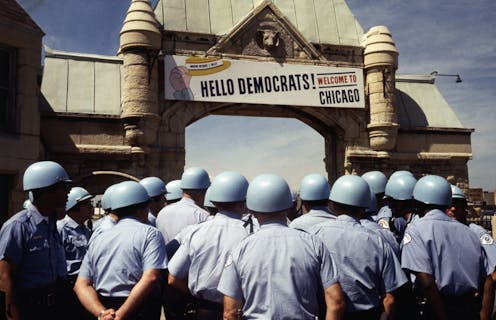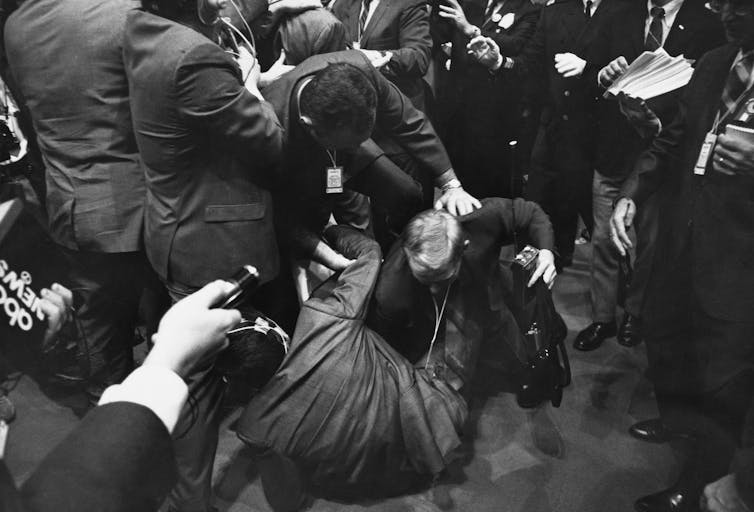2024 is not 1968 − and the Democratic convention in Chicago will play out very differently than in t
The 1968 Democratic National Convention in Chicago was a nightmare of protest, violent policing and chaos. How will Chicago handle the political and media event that is this year’s Democratic convention?

The presidential nominating conventions every four years are political events, but they are also media events. Since the advent of television, Democratic and Republican national convention organizers have sought to tightly stage-manage their gatherings for home viewers, and they’ve often succeeded.
But not always.
One of the worst misfires was the 1968 Democratic National Convention in Chicago, when anti-war activists on Michigan Avenue chanted to the TV cameras “the whole world is watching,” as Mayor Richard J. Daley’s police beat them with billy clubs. In the convention hall itself, delegates staged their own protests for the cameras, and Daley’s security forces famously punched CBS newsman Dan Rather.
Images of that chaos circulated for months, and the Democratic nominee Hubert Humphrey never fully made up the points he lost when Americans saw that violence on their TV sets.
As an expert on the 1968 convention and, in particular, on how TV news covered that crisis, I’ve been thinking about how Chicago might handle – or mishandle – the Democratic convention as both a political and a media event this August.
Fear of a ’68 replay looms large, as the city has thus far denied permits to groups seeking to gather near the United Center, site of the convention. That denial of permits feels like a page from the Daley playbook.
But just because a situation echoes the past does not mean history is repeating itself. Today’s media is completely different, and a machine politician is no longer at the helm in Chicago.
Protesters outnumbered by law enforcement
Since 1998, conventions have been legally designated as national special security events, managed largely by the Secret Service.
But back in 1968, Daley decisively held the reins. Asked whether his police had “over-reacted” to protesters, Daley declared, “The policeman is not here to create disorder. The policeman is here to preserve disorder,” a statement that was less malapropism than Freudian slip. Under his guidance, the city was secured like a fortress, as 10,000 protesters faced off against phalanxes of police and National Guardsmen, with demonstrators outnumbered 2 to 1.
Daley scared off thousands with “law and order” threats in advance of the convention, but it’s reasonable to expect a much higher number of demonstrators arriving in 2024. Chicago Mayor Brandon Johnson is a progressive who is widely perceived as more sympathetic to activists than to the police. He has not discouraged protest at the upcoming convention.
That fact alone marks a pivotal difference between Johnson and Daley. Johnson is a Democrat, but not the team player and machine boss that Daley was. Nor is he the authoritarian that Daley was. Daley had the police in his back pocket.
He did not, however, have the media in his back pocket, and neither does Johnson. In fact, even if he wanted to, Johnson could not suppress the voices of journalists, influencers, bloggers, TikTokkers and podcasters sure to descend upon Chicago.
The media ecosystem is radically different from what it was 50-plus years ago, when news was more centralized and media technologies were less portable and more difficult to obtain by nonprofessionals.
Kneecapping news reporting
Taking advantage of this top-down communications structure, Daley did everything he could to stymie journalism during the convention. Crucially, he did not resolve an electrical workers strike against the local phone company, which led to a double-edged crisis.
First, not enough extra phones were installed on the convention floor and other key areas such as convention hotels. That shortage made it difficult for print journalists to communicate with editors and call in stories. The 3,200 extra telephones installed before the convention fell far short of what was needed. It boggles the mind, but this was life before everyone carried phones in their pockets.
Second, the electrical lines and hookups the networks needed for live street coverage could not be installed because of the strike, which meant the only live TV coverage was in the convention hall itself. Film footage shot in the streets was raced by motorcycle couriers to the convention site, the International Amphitheatre, where it was developed, edited and aired.
An awkward but more accurate chant during the Battle of Michigan Avenue would have been, “The whole world will be watching in three or four hours!”
CBS, NBC and ABC understood that Daley was deliberately kneecapping them. It felt like “a total news blackout,” as exasperated CBS anchorman Walter Cronkite declared, an atypical, quick aside that perhaps only a media historian obsessively rewatching every moment of network convention coverage would pick up on.
NBC anchorman Chet Huntley reported that “the news profession in this city is now under assault by the Chicago police.” These were heavy words. Before the rise of cable news, much of which slants left or right, the professional norms dominating TV news insistently dictated neutrality. If Huntley went out on a limb to critique Chicago police, it had to be true.
Or did it? Could Huntley be trusted?

Support for police, not journalists
This is the part of the story that sounds most contemporary. In surveys taken after the convention, and mountains of letters and telegrams sent to the networks, a majority of Americans judged the police to have used an appropriate amount of force or even insufficient force against protesters.
Criticism of violence against journalists was scant. Instead, the networks were accused of “liberal bias” for showing too much violence on the part of police and not enough on the part of protesters. The CBS News archive is packed with letters from viewers decrying a lack of objectivity. Many harshly declared that Dan Rather got what he deserved.
Broadcasters responded to critics that they had merely shown what happened. A rigorous content analysis done by NBC at the time found that 3% of the network’s coverage included street demonstrations. CBS showed closer to 5%, by NBC’s estimation.
Having watched the gavel-to-gavel coverage, I can attest that, if anything, the networks undercovered police violence against protesters, not the opposite.
Suppression ‘unimaginable today’
In 1968, defenders of Daley claimed that the press told the Chicago story incorrectly, but they didn’t deny that the police had been violent. Today, by contrast, basic truths are subject to partisanship, and the belief that the mainstream media is infused with liberal bias has taken root among conservatives and those farther right.
Former President Donald Trump exploited this preexisting worldview to his benefit while in office, and after, spreading the falsehood that the 2020 election had been stolen from him.
GOP members of Congress and Fox News personalities likewise tapped into a belief among their followers that mainstream media could not be believed when they described footage of the storming of the Capitol on Jan. 6 as evidence not of an insurrection but of “sightseeing.”
Accusations of “fake news” and exclamations that the mainstream media is “the enemy of the people” have put journalists in jeopardy not only at high-profile events such as political conventions but also during their everyday work.
This will all weigh heavily in the air in Chicago in August. And at the GOP convention in Milwaukee in July.
The suppression of live coverage is unimaginable today, with mainstream media distributing instant images, and nonprofessional videos circulating like quicksilver on social media.
With phones that also function as cameras in everyone’s hands in 2024, the challenge for Americans observing both conventions from afar will be less censorship and a paucity of live imagery than the reverse – an overabundance of unsorted imagery, potentially coupled with a proliferation of disinformation, amplified by those with malicious intent.
There are many differences between the 1968 and 2024 conventions. One of the biggest is that now, the whole world is filming. The problem today is not how much we can see but how much we can believe.
Heather Hendershot does not work for, consult, own shares in or receive funding from any company or organization that would benefit from this article, and has disclosed no relevant affiliations beyond their academic appointment.
Read These Next
West Antarctica’s history of rapid melting foretells sudden shifts in continent’s ‘catastrophic’ geo
A picture of what West Antarctica looked like when its ice sheet melted in the past can offer insight…
How the ‘slayer rule’ might play a role in determining who will inherit wealth from Rob Reiner and h
These rules have a long history in the United States. They played a role in the notorious murders by…
The celibate, dancing Shakers were once seen as a threat to society – 250 years later, they’re part
‘The Testament of Ann Lee,’ Mona Fastvold’s 2025 film, depicts part of the long history of Shaker…






